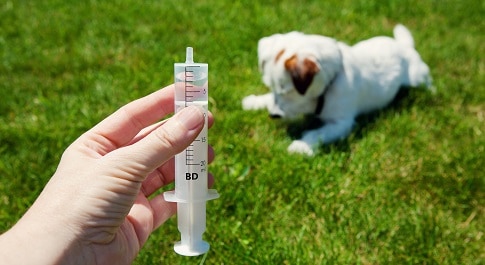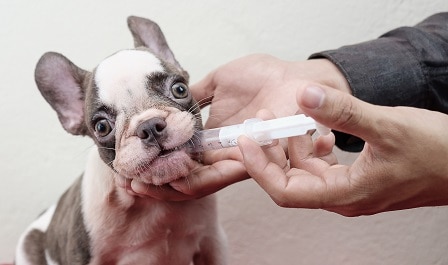Using a hand-feeding syringe (one without a needle obviously) is the most effective way to get a tiny puppy that will not take a bottle to take some food.
If you puppy won’t feed, use a syringe:
- Disposable syringes – without needles.
- With a narrow opening at the end.
- Choose ones with clearly marked measurements along the side.
- Use special formula called a canine milk replacer (ask your vet).
- Check with your vet how much they require each feed.
Newborn puppies need about 25 – 35 milliliters of food each day for every 3 ½ ounces of body weight. But it is best to check with your vet first.
If your puppy weighs in at about 14 ounces, they will require approx. 60 – 80 milliliters of milk replacer per day, so break that down into the feeds per day.
NOTE– it is better to slightly underfeed than overfeed. Too much milk or milk replacer can cause a young puppy to aspirate the fluid into their lungs.
So, you now have the food and the tool to get some food into that tiny puppy.
But that is only half the battle, you must encourage them to take the initiative and feed.
Using the Syringe to Feed Your Puppy.
For most people, the most natural way to feed a puppy is to treat them like a baby and turn them onto their back to feed.
But that is not how nature designed puppies to feed from their mother. To a puppy, lying on their back feels unnatural and may be upsetting to them.
Here is how the mother dog feeds her pups.
- All the puppies lie on their bellies to nurse. Try to mimic this posture for successful feeding.
- Wrap a very young puppy in a warm towel when you are about to feed as this will help them maintain their body temperature.
- It is probably easier to start by putting them onto a table and snuggling them with one arm (to keep them safe from wriggling and falling off the table) while gently pressing the syringe into their mouth and squeeze in a tiny bit of milk.
- THIS IS IMPORTANT – Do not try to squirt it down their throat as this can cause them to breathe some milk into their lungs, and they could choke – you do not want that! SQUIRT IT INTO THEIR MOUTH. This allows them to swallow naturally.
- Continue to squirt in small amounts, stopping for a few seconds between squirts to give the puppy time to swallow – you do not want to drown them in fluid. Patience is required to get the puppy feeding.
- At the beginning, the puppy will need to eat about every two hours, (including during the night). As they get to three weeks old, they are likely to only require about four feedings per day.
- Keep trying to introduce the bottle, especially from three weeks on, as they may take the bottle as they are used to you feeding them.
By week four, the little one can accept SMALL amounts of solids to help to transition them into eating solid foods.
It can take a lot of effort to teach a young puppy to feed, especially if they are tiny. Patience, time, and regular amounts of canine milk replacer are required.
The Syringe as an Effective Tool
It is undisputed that a mother’s milk is always best, but in a case where a puppy just will not feed correctly, for a rescued puppy, or to help the runt of the litter, a syringe provides an effective alternative to a mother’s care.
If the puppy does not take to a bottle, you will need to have plan B, and that is the syringe.
- Sometimes it may be that the bottle or teat is too big and stiff for a young pup.
- A syringe, however is much smaller, and you can squeeze small amounts into the puppy’s mouth until they get used to the taste.
- If the puppy will not eat or becomes unresponsive, you need veterinary help. If the puppy was rescued or abandoned, their body may have been without nourishment for a longer time than usual. The vet can provide emergency help and provide what the puppy needs immediately.
- Keep a pack of syringes on hand and use one per day. You can sterilize them between meals, but after a day, it is best to use a new one to ensure there is no bacterial build-up.
- Sanitation and sterilization are essential for all syringe feed pups, especially if they were unable to get colostrum (that first rich milk after they are born) from their mum. The puppy may lack the antibodies to fight infection, so keep bedding, bottles, utensils, and your hands scrupulously clean.
- Before using a new syringe, wash and rinse the syringe with warm water to clean away any manufacturer’s dust. And test the plunger to ensure it is working effectively.
When you are feeding your puppy with a syringe, stay calm and do not panic or your pup will pick up on your emotions and respond in a similar way.
Feed the puppy in a calm, confident manner; talk quietly, keep your voice soft and low, and be patient and praise your little dog to encourage them to swallow.
Feeding Syringes for Puppies.

The choices of feeding syringes for dogs are many, and the cost can vary depending on what additional extras are included. Prices range from a dollar or two, up to near $20 or more depending on what is in the packet.
- Some syringes come in a single package, while others come in a kit.
- Optional extras include different sized syringes, caps, soft rubber nipples, and some kits include a bottle for feeding at a later stage.
- Syringes that come with caps can be useful when you go out visiting and take your puppy along with you. The cap will stop the milk from squeezing out and making a mess. Do make sure you have a few full syringes or tote along a bottle of milk to fill the syringes if you are taking your puppy out, as you may end up staying longer than you planned.
- Cleaning brushes are sometimes included in the kits, andare a handy accessory to have as getting the inside of the syringe clean can be difficult without one.
- An older puppy may need a sturdier syringe, while a newborn can get away with a finer feeding tool.
- Having raised your puppy on a syringe, the experience will come in handy if you must give them medication at any stage, or feed them if they are recovering from an illness.
Tips About Feeding from a Mother Dog

If you watch a mother dog with her puppies, feeding them is only part of her duties. They have to help their youngsters to eliminate – yes you got that right – the young need to be encouraged to go to the toilet.
‘Why is this?’ you may ask yourself – ‘don’t puppies just naturally eliminate?’
And the answer is no, they have to learn to go to the toilet and after a meal is the perfect time.
Elimination is an essential part of the process. Waste is better out than held in, which can cause all sorts of problems. So how does she do it?
- A mother dog licks around the crotches of the puppies to stimulate urination and defecation. They do this after the puppies have finished feeding, and they do it to clean the area up.
- Do not panic, we aren’t going there, but we can simulate what she does.
- Get a soft damp cloth and gently wipe around and around their private parts until you see them urinate or poop. Puppies will usually pee after a meal, but they don’t always poop. Switch to a clean cloth and dry off.
- As your puppy grows, they will naturally go to the toilet after they feed. It may take a few minutes to work, as a growing puppy is easily sidetracked. Just gently put them back on the toilet pad to do their business before they bumble away to play.
- Getting the puppy into a habit of going to the toilet after every meal will save puppy puddles and poop around the house!
Nature is a mighty thing; she tends to have it all worked out. All we must do is mimic the mother dog, and before you know it, you will have a happy, healthy little puppy romping by your side.
In Conclusion

When a puppy will not feed on a bottle, then the best option is to use the syringe, at least to get them to start feeding.
The syringe is an easy method to start a little pup off. They are also relatively inexpensive so having one on hand is a good thing. You never know when you may need it.
While the method can be a bit messy at the beginning, once your puppy realizes yummy things for their tummy come out of it, they will become very cooperative.
The syringe can come in handy when giving medicines to a puppy, having to feed an injured young dog back to health, or to get food into a puppy when it has a dental abscess or painful tooth and doesn’t want to eat.
Keep one or more on hand, you never know when you may need it.
Writer: Jean Brewer


